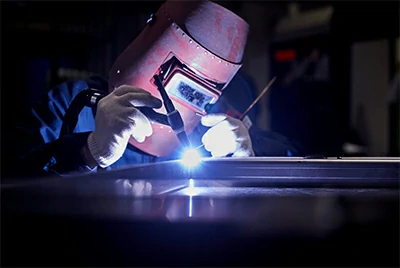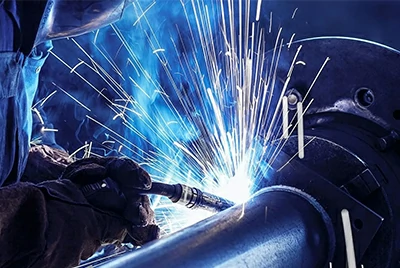Titanium Pressure Vessels
Updated : Oct. 24, 2025Titanium Pressure Vessels
Titanium pressure vessels are fabricated from commercially pure titanium or titanium alloys (shell, heads, nozzles, etc.) and are used to store or convey aggressive media under specified temperature and pressure.
They provide long-term corrosion resistance to wet chlorine, chloride-bearing media, seawater, and a range of acids and alkalis, while their high strength-to-weight ratio and low density reduce downtime and maintenance. They also meet high-purity/low-leachables requirements, delivering a lower total cost of ownership.
For continuous service, ≤250 °C is recommended; ≥300 °C requires dedicated evaluation.
Introduction to Titanium Pressure Vessels
A titanium pressure vessel uses titanium/titanium-alloy shell, heads, nozzles, and manways to store or process corrosive media at defined temperature/pressure. It resists seawater/chlorides/acids, has a high strength-to-weight ratio and low leachables—improving uptime and purity.
Typical uses: chlor-alkali, desalination/offshore cooling, fine chemicals, electrolysis/electroplating. Choose full titanium for small–medium size, low–medium pressure, and high-purity needs; pick Ti-clad on steel for thick-wall, high-pressure, or large-diameter economics.
Design to ASME Section VIII; qualify welding per ASME Section IX. Use ASTM/ASME SB materials (e.g., B265/B348/B338/B861/B381/B363) and verify with hydro/pneumatic tests, optional helium leak tests, and NDT (RT/UT/PT).
Specifications & Compliance
Design code: ASME BPVC Section VIII (Div. 1 / Div. 2)
WPS/WPQ: per ASME Section IX
Strip/Sheet/Plate: ASTM B265 / ASME SB-265
Bar: ASTM B348 / ASME SB-348
Pipe: ASTM B861 (seamless) / B862 (welded) = ASME SB-861 / SB-862
Heat-exchanger tubing: ASTM B338 / ASME SB-338
Forgings: ASTM B381 / ASME SB-381
Pipe fittings: ASTM B363 / ASME SB-363
Scope & Parameters
| Category | Typical range / notes |
|---|---|
| Material grades | CP titanium Gr1/Gr2; alloys Gr7 (Pd-modified, for crevice/reducing media) / Gr12; Gr5 can be considered where higher strength is required (weldability/corrosion to be specially qualified). |
| Design temperature | Typically –50 °C to 300 °C; ≤ 250 °C recommended for continuous service to mitigate activation/embrittlement risks. |
| Design pressure | Typically ≤ 4.0 MPa (≈ 40 bar); final rating determined by ASME calculations and material/thickness. |
| Geometry | Diameter ≤ 3048 mm (120 in); length ≤ 7620 mm (300 in); wall thickness ≤ 75 mm (≈ 2.95 in). |
| Configurations | Vertical/horizontal vessels, columns, heat-exchanger shells / tube sheets, etc. |
| Documentation & testing | EN 10204 3.1/3.2 MTC; NDT (UT/RT/PT); hydrostatic & pneumatic/leak tests; third-party witnessing as required. |
| Applicable standards | ASME Section VIII (design/manufacture/inspection), ASME Section IX (welding qualification); common material specs ASTM B265/B338/B381, etc.; PED/NACE as project requirements dictate. |
Components of Titanium Pressure Vessels
Pressure Boundary
The shell and shell courses are rolled from CP titanium plate (ASTM B265) and butt-welded, with Gr2/Gr7/Gr12 selected per medium and service; the inner surface can be polished and cleaned. Heads are of matching material, supporting spin forming and post-weld reshaping in elliptical, dished, conical, or flat types. Manways/handholes can be quick-open or bolted, with sanitary seals and optional sight light/sight glass.

Nozzles & Ends
Process nozzles cover feed/withdrawal, circulation, vent/blanket, and drain/condensate points, typically paired with titanium pipe (ASTM B338); reinforcement pads and internal flow liners/guides can be added as needed. End connections include titanium flanges (RF/FF/TG/RTJ), Tri-Clamp sanitary ferrules, threaded (NPT/BSP/Metric), and butt-weld ends. Gaskets and fasteners are available in titanium, nickel-base, and non-metallic options; fasteners can be all-titanium or corrosion-matched.

Internals
Internals can include flow guides, baffles, and partitions to optimize residence time and mass transfer. Distribution/collection systems comprise spray pipes, distributors, trays, strainers/baskets, and mist eliminators (wire-mesh or vane). Erosion-prone zones may use wear liners or replaceable liners; integrated heat-exchange/filtration designs can add titanium tube sheets, tube bundles, or cartridge seats.

Supports & Cladding
Support options include saddles, skirts, legs/lugs, and lifting lugs, with lifting points and center-of-gravity marks provided before shipment. Insulation and jacketing can be configured with mineral wool/aerogel plus aluminum/stainless jackets, with proper condensate control and drainage. During transport or standby, nozzles are protected with blinds/caps and the vessel can be internally preserved (e.g., inert-gas purge).
Instrumentation & Safety
Instrument connections are provided for pressure, level (magnetic/DP/radar), thermowells, and sampling. Safety protection includes safety valves and rupture discs in single or series/parallel arrangements, with third-party witnessing available. Service openings and sight glasses facilitate online inspection and CIP/SIP cleaning and maintenance.
Full Titanium vs. Ti-Clad Pressure Vessels
| Key metric | Full titanium pressure vessel | Ti–steel clad pressure vessel (ASTM B898) | Recommendation |
|---|---|---|---|
| Corrosion boundary | Most robust: excellent in high-chloride, wet chlorine, seawater splash/crevice conditions. | Media side protected by titanium layer; performance depends on cladding quality and edge sealing. | Extreme/ultra-pure/stagnant seawater → Full titanium |
| Cost | Higher CAPEX due to expensive base and filler metals. | ~20–60% lower than full titanium. | Budget-sensitive or very large projects → Clad |
| Weight | Lighter; better for lifting and offshore platforms. | Steel substrate carries load; heavier deadweight. | Weight-critical → Full titanium |
| Size & thick-wall | Costs rise sharply for very large sizes or thick walls. | More economical/schedulable for large diameter and thick-wall units. | Very large or thick-wall → Clad |
| Maintenance & risk | No dissimilar interface; typically liner-free and low maintenance. | Must monitor bond/edge delamination and leakage over life. | High downtime cost → Full titanium |
| Typical applications | Chlor-alkali, seawater/desalination, vacuum/ultra-pure service, aerospace cryogenic tanks. | Absorbers/scrubbers, heat-exchanger shells, large storage tanks. | Hybrid possible: full titanium on critical wetted areas + clad elsewhere. |
Applications
Chlor-alkali / chlorine-bearing oxidizing systems
Full-titanium pressure vessels are widely used for reactors, scrubbers, storage tanks, manways and nozzles. Titanium’s inherent resistance to pitting, crevice corrosion and stress-corrosion cracking in chloride media enables long, liner-free service, cutting downtime and maintenance. It solves common stainless-steel failures in chlorides (pitting, rubber-lining peel-off and leakage).


Seawater / desalination & offshore cooling
For desalination shells, seawater cooler shells and seawater tanks, full titanium combines seawater corrosion resistance with low weight. It maintains performance at high flow velocities and extends re-tubing/maintenance intervals—addressing rapid corrosion, coating failure and scaling-related leakage typical of carbon-steel/coating systems.
Fine chemicals / PTA / acidic media
In reactors, crystallizers, filter housings and connecting spools, titanium’s clean surface and low metal leachables resist a wide range of acids, lowering batch contamination risk. It avoids secondary contamination from liner delamination and reduces shutdowns from leaks or re-lining.
Electrolysis / SX-EW, electroplating & water treatment
For electrolyte tanks, coolers, filter housings and dosing/neutralization vessels, titanium withstands acid-halide systems and chlorine-based disinfectants; its surface cleans easily and resists fouling. It outperforms copper/stainless in acid mist and chloride environments, reducing patch leaks and replacements and boosting uptime.


Weight-sensitive equipment / aerospace & new energy
In lightweight vessels, gas bottles and specialty chemical units, titanium’s high strength-to-weight ratio, corrosion resistance and low density deliver significant mass reduction without compromising safety—solving over-weight and rust-driven reliability issues in traditional steel equipment.
Manufacturing
Welding
Pre-weld cleaning: Prepare bevels/grooves as required and remove oxide, grease, burrs and dust within 25 mm on both sides using dedicated stainless or non-metallic brushes; finish with acetone or ethanol to ensure a clean, dry surface.
Shielding: Use dedicated trailing shields/top-and-back protection throughout welding; coordinate operators so shielding remains until the weld has cooled. Backside protection is critical, especially for single-sided welding or double-sided forming.
Technique: Maintain an appropriate root gap for a stable arc/puddle. Keep the tungsten close and welding continuous and stable while monitoring pool depth and flow; strictly follow qualified current levels (no over-current). Allow specified cooling time between passes. Keep the area dry and dust-free; ambient air velocity < 2 m/s to avoid arc instability.


Machining
Use one-setup turning–milling–boring to finish flange sealing faces, nozzle bores and bolt holes. Flange faces per ASME B16.5 (RF/FF/TG/RTJ); end connections support NPT/BSP/Metric threads and Tri-Clamp sanitary ferrules. Prepare nozzle bevels per code and drawing; finish-machine sealing faces after welding. Dedicated fixtures and in-process inspection ensure geometry and interchangeability with standard gaskets and piping.


Surface treatment
Follow titanium-specific cleanliness: degrease → DI-water rinse → pickling/weld-discoloration removal → passivation → clean drying. Optional mechanical/electropolishing improves cleanability and flow; blind cavities are designed to be CIP/SIP-friendly. Before shipment, perform visual/borescope checks and leak/pressure tests, fit blinds/caps on all ports, apply inert-gas preservation as needed, and pack in export crates with reinforced bases.
Inspection & Testing
Nondestructive examination (NDE).
Conduct UT/RT/PT on designated pressure parts and critical welds in accordance with the drawings and applicable standards; retain original indications/films and reports to ensure full traceability.
Pressure and leak testing.
Perform hydrostatic or pneumatic tests per ASME BPVC UG-99/UG-100, following approved ITP/ATP procedures. For high-purity or vacuum service, add helium mass-spectrometer leak detection (MSLD) with acceptance sensitivity as specified in the contract/ITP (e.g., ≤ 1×10⁻⁶ mbar·L/s). Suspect locations shall be isolated and re-tested until acceptance criteria are met.
Incoming and critical component verification.
Verify chemical composition via ICP-OES/PMI; perform mechanical tests (e.g., ASTM E8/E23) where required; complete dimensional and visual inspections against approved drawings and data sheets.
Traceability and deliverables.
Maintain heat/lot traceability for materials, filler metals, and shielding gases throughout manufacturing. Deliver a documentation package including EN 10204 3.1/3.2 MTC, qualified WPS/PQR/WPQ, NDE reports, hydro/pneumatic/helium test records, packing & preservation instructions; arrange third-party witnessing (e.g., SGS/BV/DNV/TÜV) or resident inspection when specified.
FAQ (Technical)
Q1. What is the "best” metal for a pressure vessel?
A. It depends on service: 304/316L/duplex (2205/2507) for general corrosion with moderate chlorides; nickel alloys for high-temperature, strongly oxidizing/reducing acids; titanium/titanium alloys for seawater, wet chlorine, hypochlorites, chloride-oxidizing systems, and high-purity media—offering long service life and lower total cost of ownership in such environments.
Q2. Can titanium withstand deep-sea (external) pressure?
A. Yes—when designed for external pressure. Capacity is governed by geometry, wall thickness, stiffening, and buckling checks per ASME Section VIII external-pressure charts. Common practice employs spherical shells or short cylinders with stiffening rings/ribs, followed by external-pressure testing and NDE.
Q3. Does titanium crack under pressure?
A. Not when code-compliant design and qualified welding are applied. Risks arise from hydrogen pickup/embrittlement, weld contamination (O/N/H), sharp notches/stress raisers, or incompatible media (e.g., HF/fluorides). Mitigations include Pd-bearing grades (Gr7/Gr16) for crevice/reducing environments, full inert-gas protection during welding, strict contamination control, and post-weld de-hydrogenation/re-passivation where required.
Q4. Is a corrosion allowance required for titanium vessels?
A. Often low or zero, given typically low corrosion rates in the intended media. Where crevices/deposits/erosion are expected, specify a local allowance, wear liners, or reinforced details based on velocity and geometry.
Q5. Will Ti-clad (titanium-on-steel) vessels delaminate? How is integrity assured?
A. When using compliant explosion-/roll-bonded plate with interface UT, proper edge encapsulation/overlay, and qualified weld procedures, long-term service is achievable; in-service local liner repairs are possible if needed.
Q6. Is helium leak testing mandatory?
A. It is strongly recommended for high-purity, vacuum, toxic, or high-value services due to its superior sensitivity versus hydro/pneumatic tests. For general services, follow the code and contractual requirements.
Q7. Is titanium suitable for pharma/food/UPW systems?
A. Yes. Titanium offers high cleanliness, corrosion resistance, and biocompatibility, supports CIP/SIP and re-passivation; select appropriate surface roughness/cleanliness classes and control particulates/metal leachables to meet process specifications.
Q8. How should gaskets and flange faces be selected?
A. Prefer ePTFE/PTFE or spiral-wound with titanium strip, commonly on RF faces; RTJ is reserved for specific high-pressure services. Apply manufacturer torque tables and verify bolt load to prevent cold-flow and loosening.




